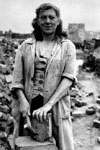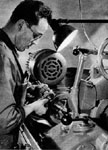 The
first phase of East German photography, beginning in the late 1940s
and institutionalized with the establishment of the Central Commission
for Photography (ZKF) in 1960, represents a deliberate severance from
western traditions. The first generation of East German photographers,
including many who had participated in the worker photography movement
of the 1930s such as Walter Ballhause and Eugen Heilig, focused on documenting
the construction of socialism in Germany and developing an iconography
of the peasant and workers' state. An heroic image of the worker was
articulated by artists such as Paul Damm and Käte Basarke, and
a distinct East German style emerged characterized by realism in form
and narrative. Of particular importance were photographic depictions
of key socialist "types" and moments, carefully posed to enhance
their drama of purpose and clarity of meaning. The
first phase of East German photography, beginning in the late 1940s
and institutionalized with the establishment of the Central Commission
for Photography (ZKF) in 1960, represents a deliberate severance from
western traditions. The first generation of East German photographers,
including many who had participated in the worker photography movement
of the 1930s such as Walter Ballhause and Eugen Heilig, focused on documenting
the construction of socialism in Germany and developing an iconography
of the peasant and workers' state. An heroic image of the worker was
articulated by artists such as Paul Damm and Käte Basarke, and
a distinct East German style emerged characterized by realism in form
and narrative. Of particular importance were photographic depictions
of key socialist "types" and moments, carefully posed to enhance
their drama of purpose and clarity of meaning.  "Socialist
realism represents reality in its revolutionary development, in its
most progressive appearances. From these appearances, it then chooses
the most basic, typical, and characteristic," Professor W.P. Jefanow,
Secretary of the Union of Soviet Fine Artists, declared in an interview
in Die Fotografie. "The main task of the artist is to render
man and his life in all its variety." (DF 12/53, p. 331) "Socialist
realism represents reality in its revolutionary development, in its
most progressive appearances. From these appearances, it then chooses
the most basic, typical, and characteristic," Professor W.P. Jefanow,
Secretary of the Union of Soviet Fine Artists, declared in an interview
in Die Fotografie. "The main task of the artist is to render
man and his life in all its variety." (DF 12/53, p. 331)
|

 The
first phase of East German photography, beginning in the late 1940s
and institutionalized with the establishment of the Central Commission
for Photography (ZKF) in 1960, represents a deliberate severance from
western traditions. The first generation of East German photographers,
including many who had participated in the worker photography movement
of the 1930s such as Walter Ballhause and Eugen Heilig, focused on documenting
the construction of socialism in Germany and developing an iconography
of the peasant and workers' state. An heroic image of the worker was
articulated by artists such as Paul Damm and Käte Basarke, and
a distinct East German style emerged characterized by realism in form
and narrative. Of particular importance were photographic depictions
of key socialist "types" and moments, carefully posed to enhance
their drama of purpose and clarity of meaning.
The
first phase of East German photography, beginning in the late 1940s
and institutionalized with the establishment of the Central Commission
for Photography (ZKF) in 1960, represents a deliberate severance from
western traditions. The first generation of East German photographers,
including many who had participated in the worker photography movement
of the 1930s such as Walter Ballhause and Eugen Heilig, focused on documenting
the construction of socialism in Germany and developing an iconography
of the peasant and workers' state. An heroic image of the worker was
articulated by artists such as Paul Damm and Käte Basarke, and
a distinct East German style emerged characterized by realism in form
and narrative. Of particular importance were photographic depictions
of key socialist "types" and moments, carefully posed to enhance
their drama of purpose and clarity of meaning.  "Socialist
realism represents reality in its revolutionary development, in its
most progressive appearances. From these appearances, it then chooses
the most basic, typical, and characteristic," Professor W.P. Jefanow,
Secretary of the Union of Soviet Fine Artists, declared in an interview
in Die Fotografie. "The main task of the artist is to render
man and his life in all its variety." (DF 12/53, p. 331)
"Socialist
realism represents reality in its revolutionary development, in its
most progressive appearances. From these appearances, it then chooses
the most basic, typical, and characteristic," Professor W.P. Jefanow,
Secretary of the Union of Soviet Fine Artists, declared in an interview
in Die Fotografie. "The main task of the artist is to render
man and his life in all its variety." (DF 12/53, p. 331)